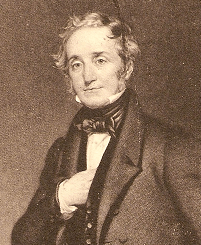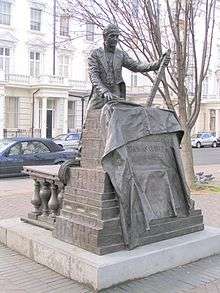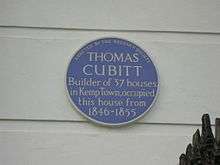Thomas Cubitt
| Thomas Cubitt | |
|---|---|
 | |
| Born |
25 February 1788 Buxton, Norfolk, England |
| Died |
20 December 1855 (aged 67) Denbies, Surrey, England. |
| Occupation | Architect |
| Buildings | The London Institution, Buckingham Palace, Osborne House |
| Projects | Belgrave Square, Lowndes Square, Chesham Place |
| Design | Eaton Square, Battersea Park |
Thomas Cubitt (25 February 1788 – 20 December 1855) was an English master builder in the second quarter of the 19th century who mostly worked in London but also carried out several projects in other parts of England.
Background
The son of a Norfolk carpenter, he journeyed to India as ship's carpenter from which he earned sufficient funds to start his own building firm in 1810 on Gray's Inn Road, London where he was one of the first builders to have a 'modern' system of employing all the trades under his own management.[1]
Work

Cubitt's first major building was the London Institution in Finsbury Circus, built in 1815.[2] After this he worked primarily on speculative housing at Camden Town, Islington, and especially at Highbury Park, Stoke Newington (now part of Hackney).[3]
His development of areas of Bloomsbury, including Gordon Square and Tavistock Square, began in 1820, for a group of landowners including the Duke of Bedford.[4]
He was commissioned in 1824 by Richard Grosvenor, 2nd Marquess of Westminster, to create a great swathe of building in Belgravia centred on Belgrave Square and Pimlico, in what was to become his greatest achievement in London.[5] Notable amongst this development are the north and west sides of Eaton Square, which exemplify Cubitt's style of building and design.[5]
Cubitt was also responsible for the east front of Buckingham Palace.[6] He also built and personally funded nearly a kilometre of the Thames Embankment.[7] He was employed in the large development of Kemp Town in Brighton, and Osborne House on the Isle of Wight, completed in 1851.[6] Cubitt's public works included the provision of public parks, including being an organiser of the Battersea Park Scheme.[8]
In 1827 he withdrew from the management of the business he had established at Gray's Inn Road leaving such matters to his brother William Cubitt; the firm of Cubitts still carried out the work of Thomas Cubitt and the change robbed neither of the partners of the credit for their work.[6]
Family
Cubitt had two brothers, the contractor and politician William and the civil engineer Lewis who designed many of the houses built by Thomas.
His son by his wife Mary Anne Warner, George, who was created Baron Ashcombe in 1892, was the great-great-grandfather of Camilla, Duchess of Cornwall.
Legacy
He died in 1855[6] and was taken from Dorking for burial at West Norwood Cemetery on 27 December 1855.
After his death, Queen Victoria said, "In his sphere of life, with the immense business he had in hand, he is a real national loss. A better, kindhearted or more simple, unassuming man never breathed."[9]
Another statue of Cubitt can be seen in Dorking, opposite the Dorking Halls, as he was favoured there for his architecture on his Denbies estate.[10]
In 1883 the business was acquired by Holland & Hannen, a leading competitor, and the combined business became known as Holland & Hannen and Cubitts and subsequently as Holland, Hannen & Cubitts.[11]
Restaurants, pubs and other places have been named in honour of him.[12]
References
- ↑ Holland & Hannen and Cubitts - The Inception and Development of a Great Building Firm, published 1920, Page 17
- ↑ Holland & Hannen and Cubitts - The Inception and Development of a Great Building Firm, published 1920, Page 19
- ↑ Holland & Hannen and Cubitts - The Inception and Development of a Great Building Firm, published 1920, Page 25
- ↑ Holland & Hannen and Cubitts - The Inception and Development of a Great Building Firm, published 1920, Page 27
- 1 2 Holland & Hannen and Cubitts - The Inception and Development of a Great Building Firm, published 1920, Page 29
- 1 2 3 4 Holland & Hannen and Cubitts - The Inception and Development of a Great Building Firm, published 1920, Page 35
- ↑ Holland & Hannen and Cubitts - The Inception and Development of a Great Building Firm, published 1920, Page 31
- ↑ Holland & Hannen and Cubitts - The Inception and Development of a Great Building Firm, published 1920, Page 33
- ↑ London By Stephen Halliday
- ↑ "Mary Ann Cubitt of Denbies – a detective story By Mark Cortino with biographical notes by Kathy Atherton". Dorking Museum. Archived from the original on 21 January 2012.
- ↑ Cubitts 1810 - 1975, published 1975
- ↑ "Cubit House". Retrieved 28 September 2014.
External links
| Wikimedia Commons has media related to |
